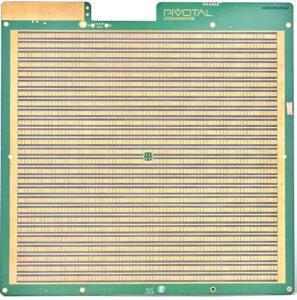The Right Way to Think About MIMO
By Eric Black PhD, CTO

My personal survey of analyst reports and vendor datasheets on antenna arrays suggests growing confusion about what MIMO really means. I’ve observed MIMO-esque terms like '128T/128R' used to describe single-radio backed passive antenna arrays that do not even scan. This is a clear example of tricking antenna prospects into thinking they are getting some kind of ‘supermassive MIMO’ system at bargain prices. If the number of antenna elements really is the metric of interest, then Pivotal Commware wins handily with its 2002T/2002R element ATG (air-to-ground) antenna (Figure 1). Take that you puny 64T/64R systems! While this metric makes Pivotal’s Holographic Beam Forming® (HBF) antennas appear better than they already are, I argue that this is not a good thing for industry to tolerate from vendors.
A similar abuse surrounds the word ‘channel.’ I have seen a few vendors describe the outputs fanning out in the analog sense from a single input fed by a single radio chain as being ‘channels.’ These vendors claim to have, for example, a 16-channel beamforming IC with only one or two radio inputs. By this measure, HBF has demonstrated thousands of channels in a single aperture. It’s nonsense but I believe vendors do it intentionally because I’ve observed that even capable analysts can be misled.
Let’s keep MIMO nomenclature properly descriptive. When one uses the T/R or channel count descriptor, from a MIMO perspective, they should be exclusively referencing the number of actual signal processing chains used for transmission and reception within the device. Even this is slightly controversial as many of the academic publications on MIMO communications use the same nomenclature to describe a link. So, among academics, a 64T/8R would mean a device with 64 radio chains transmitting to an unknown number of devices that collectively total eight receiving radio chains. I prefer the industry version as we really do not control the number of devices on the other end of a cellular link. A descriptor that can be correct within a datasheet seems preferable.
Why does this matter? Analog beamforming dominates the millimeter wave (mmW) space because of two challenging realities in above-X-band systems. One is that the power efficiency of amplifiers is downward trending with frequency, so there is meaningful benefit to using fewer, high quality, linearizable power amplifiers (PAs). The second is that direct digitization requires linearly increasing power with sample rate and exponential power consumption scaling with the number of bits of resolution. The direct digitization of mmW appears hopeless with each DAC burning nearly a watt if sampling the signal at Nyquist with eight bits of resolution.
Several articles have shown that for moderate arrays (more than 32 elements) the number of bits can be reduced to as few as four, and by employing either RF down-conversion or anti-alias strategies (both tolerating lower required sample rates), power consumption for the DAC/ADCs becomes competitive with a pure analog solution. However, the baseband processing power required behind the ADCs still skyrockets with the number of ‘channels’ that need to be co-processed within either the local radio or, for less latency-sensitive applications, an external system. At mmW, the large arrays (usually at least 32 active half-wavelength elements) drive to difficult power consumption challenges. So analog beamforming remains the preferred option for the near future at mmW. This makes the odd attempt to market phased array chipsets as digital beamformers particularly odd. These chips can neither accomplish any of the imagined benefits of MIMO nor reach the low-power consumption of HBF platforms with their greatly reduced RF hardware complexity.

